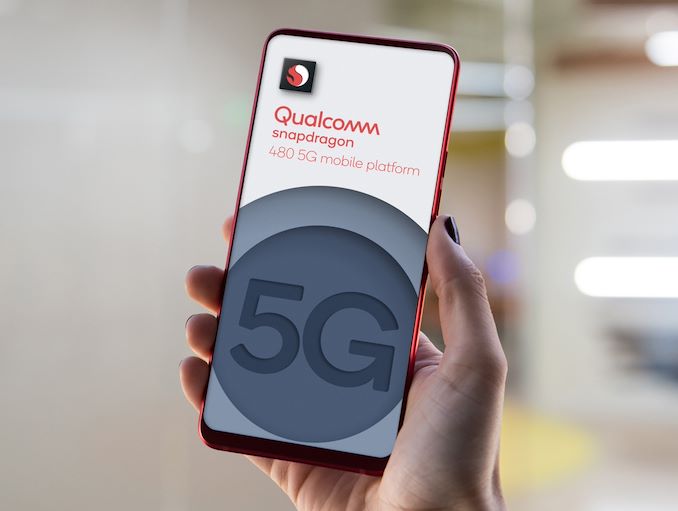Today, Qualcomm is taking a big step towards enabling widespread adoption of 5G through announcements of the new low-cost Snapdragon 480 5G SoC. The company had already mentioned a few months ago that it would be launching a Snapdragon 400 series design with 5G compatibility, bringing the new standard of connectivity to the lowest cost devices in the market, aiming at the price range of $ 250 of very high volume.
The new Snapdragon 480 is an extremely impressive SoC not only because of its list of 5G features, but also because it is a major performance upgrade in many ways, including using two Cortex-A76 cores as its main performance CPUs – a very big leap in the 400 series family, probably representing a huge leap in performance for millions of low-cost devices on the market.
| Qualcomm Snapdragon 400 SoCs | |||||||
| SoC | Snapdragon 439 | Snapdragon 450 | Snapdragon 460 |
Snapdragon 480 |
|||
| CPU | 4x CA53 @ 2.2GHz 4x CA53 |
8x CA53 @ 2.3 GHz |
4x Kryo 240 (CA73) @ 1.8GHz 4x Kryo 240 (CA53) |
2x Cortex-A76 @ 2.0 GHz 6x Cortex-A55 |
|||
| GPU | Adreno 505 | Adreno 506 | Adreno 610 | Adreno 619 | |||
| DSP | Hexagon 536 | Hexagon 546 | Hexagon 683 | Hexagon 686 | |||
| ISP / Camera |
Spectra
21 MP single |
Spectra
21 MP single |
Spectra 340
36 MP single |
Spectra 345
64 MP single |
|||
| Code/ Decode |
1080p30 H.264 |
1080p60 H.264 and H.265 |
|||||
| Memory | 1x 32 bit at 933 MHz LPDDR3 7.4 GB / s |
2x 16 bits at 1866 MHz LPDDR4X 14.9 GB / s |
2x 16 bits at 2133 MHz LPDDR4X 17.0 GB / s |
||||
| Integrated Modem | Snapdragon X6 LTE (Category 4/5) DL = 150Mbps UL = 75 Mbps |
Snapdragon X9 LTE (Category 7/13) DL = 300Mbps UL = 150Mbps |
Snapdragon X11 LTE (Cat 12/13) DL = 390Mbps UL = 150Mbps |
Snapdragon X51
LTE 5G NR DL = 2500Mbps |
|||
| Mfc. Process | 12nm LPP | 14nm LPP | 11nm LPP | 8 nm LPP | |||
Starting with the CPU configuration, the new Snapdragon 480 is quite exciting for a low-cost SoC as it dispenses with the older Cortex-A73 cores from the previous generation Snapdragon 460 for a pair of newer Cortex-A76 cores, running at 2.0GHz . This is not the newest CPU IP on the market, however, the leap from an A73 to an A76 is extremely large in terms of single-thread performance and is set to bring significant user experience benefits to new devices using Snapdragon 480. The new SoC has a 2 + 6 CPU design, unlike its predecessor’s 4 + 4 configuration – multi-threaded performance may not be as great, but for this SoC class I don’t see this as a problem. The CPU configuration actually looks almost identical to what we saw on the Snapdragon 675 – these parts would be good indicators of what to expect from the new design of the 480.
On the GPU side, we are seeing an upgrade from an Adreno 610 to an Adreno 619 – Qualcomm here promises a 100% increase in performance over its predecessor on the Snapdragon 460.
On the memory side, this is still a low-cost 2x16b SoC LPDDR4X, however, we saw a slight increase in frequencies to 2133MHz.
AI performance is said to have increased by 70%, in part due to the upgrade to a new Hexagon 686 DSP block with vector extensions and tensioner. Interestingly, on the camera side, Qualcomm mentions that they implemented a triple-ISP system, a feature that was only recently announced in the flagship Snapdragon 888 a few weeks ago. Maximum sensor resolutions are 64 MP for a single module, 25 + 13 MP in dual camera mode or 13 + 13 + 13 MP in triple sensor capture mode.
Interestingly, although the ISP’s resources have grown in this generation, the video encoder is still limited to 1080p60 H.264 / H.265. Qualcomm also reports that the display controller reaches a maximum of 1080 x 2520, although it supports refresh rates up to 120Hz.
5G in the low end
Although the Snapdragon 480 was impressive only with the mentioned specification updates, the great feature of the new generation of SoC is its new modem subsystem that fully supports 5G NR.

The integrated X51 modem supports up to 800 Mbps downlink LTE and 210 Mbps uplink, as well as combined 5G sub-6 throughput and 2500 Mbps downlink mmWave and 660 Mbps uplink. The spectrum capacity below 6 GHz drops to 100 MHz, but what is very surprising to see is that, although the chipset is a low-cost design, it still features mmWave features – albeit with very wide spectrum bandwidth. smaller compared to flagship larger modems, dropping to just 200MHz. Given that mmWave currently plays an important marketing role in 5G deployments in the US, having any support for the new technology is a must to achieve victories in device design, even if it is a somewhat contradictory feature to have in a lower segment. cost sensitive devices.
The X51 modem is capable of all important new 5G technologies, supporting 5G FDD and TDD autonomous (SA) and non-autonomous (NSA) 5G networks, as well as DSS (Dynamic Spectrum Sharing).
Then, a new chip is manufactured in Samsung’s 8 nm process node, which should provide very good energy efficiency.
Partner suppliers included in Qualcomm’s announcement included HMD Global, OPPO and Vivo, endorsing the new chipset. Most interestingly, OnePlus was also among the vendors noticing the new chipset – maybe that signals the arrival of a new low-cost OnePlus device?
Qualcomm expects the first Snapdragon 480 devices to be announced this month.
